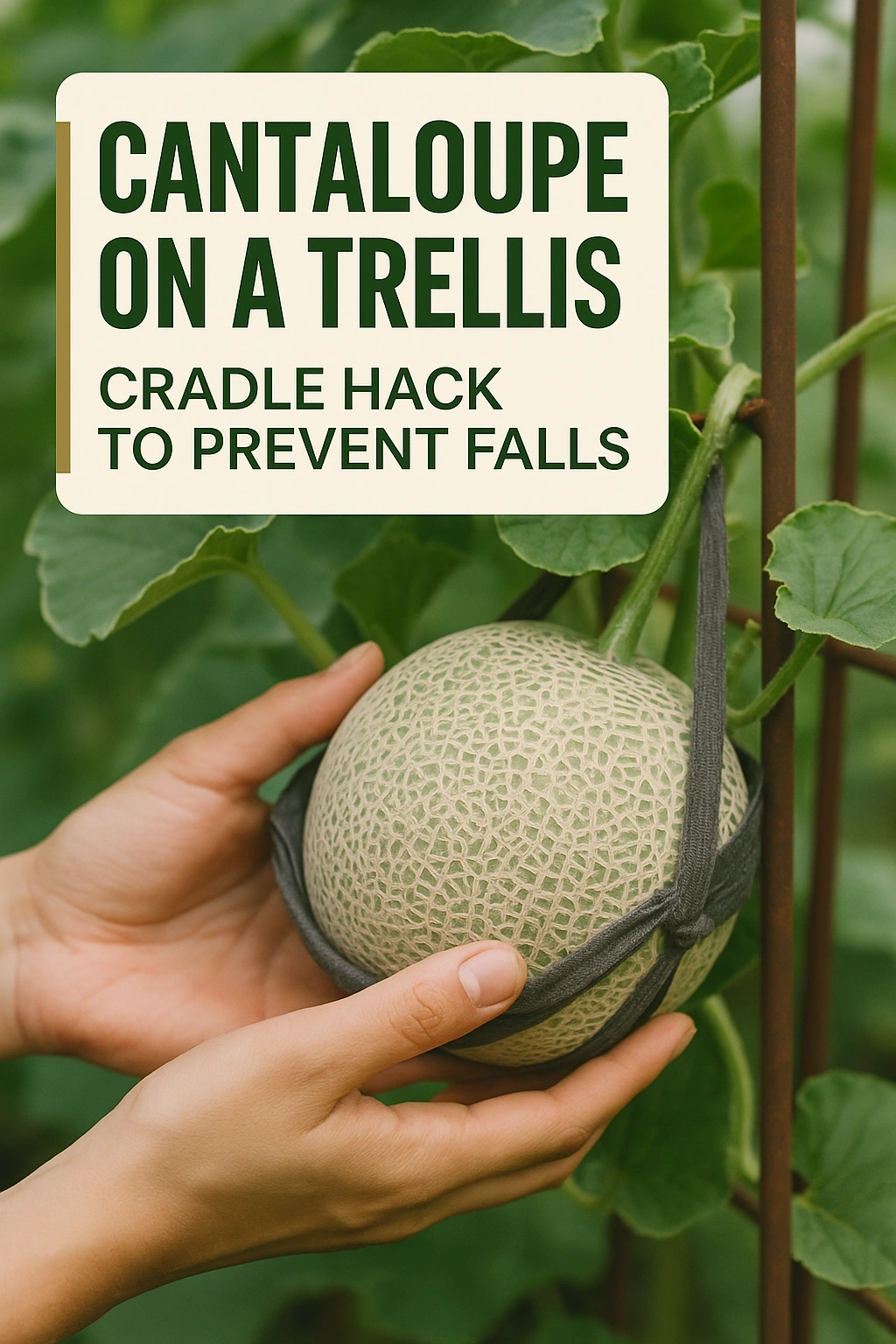
Growing cantaloupe can be a rewarding endeavor, but it comes with its challenges, particularly when it comes to supporting the heavy fruit as it matures. Utilizing a trellis is an innovative solution that not only maximizes space but also encourages healthier plants. However, without proper support, the melons may fall, leading to bruising and potential disease. This article explores effective techniques for trellising cantaloupe, particularly focusing on the ingenious cradle hack to prevent falls and ensure a bountiful harvest.
Understanding the Benefits of Trellising Cantaloupe
Trellising cantaloupe offers numerous advantages that can enhance your gardening experience. First and foremost, it allows for better air circulation around the plants, reducing the risk of fungal diseases. Elevated fruit is also less susceptible to pests and ground rot. Furthermore, trellising can facilitate easier harvesting, as you won’t need to bend down or sift through foliage to find your ripe melons. This method can also optimize your garden space, allowing for more plants in a smaller area.
Choosing the Right Trellis for Cantaloupe
When it comes to trellising cantaloupe, selecting the appropriate type of trellis is crucial. The trellis must be sturdy enough to support the weight of mature melons while also providing adequate space for growth. There are several types of trellises that can be effective for cantaloupe, including A-frame, vertical, and horizontal trellises.
A-Frame Trellis
An A-frame trellis is a popular choice among home gardeners. It provides a stable structure that allows cantaloupe vines to climb upwards. This design not only supports the fruit but also maximizes sunlight exposure, which is vital for ripening. Constructing an A-frame trellis is relatively straightforward, requiring minimal materials.
Vertical Trellis
A vertical trellis is another effective option, particularly for those with limited space. Installed against a wall or fence, this type of trellis encourages the cantaloupe vines to grow upwards. Ensure that the trellis is tall enough to accommodate the growth of the plants and the weight of the fruit.
The Cradle Hack: Supporting Your Cantaloupe
While trellising is essential, the cradle hack takes support to the next level. This method involves creating a small cradle or sling for each cantaloupe, ensuring that they are securely held in place as they grow. This technique can significantly reduce the stress on the vine and prevent the fruit from falling off prematurely.
How to Create a Cantaloupe Cradle
Creating a cradle for your cantaloupes is simple and requires only a few materials. You will need soft fabric, such as old t-shirts or mesh bags, and some twine or string for securing the cradle to the trellis. Begin by cutting the fabric into squares, large enough to hold the cantaloupe comfortably.
Steps to Implement the Cradle Hack
- Prepare the Fabric: Cut the material into squares that can easily wrap around the fruit.
- Attach the Sling: Tie the fabric to the trellis in a way that allows the cantaloupe to rest comfortably.
- Adjust as Needed: As the fruit grows, ensure the cradle is adjusted to support the weight without constricting the vine.
Additional Tips for Growing Cantaloupe on a Trellis
Beyond the cradle hack, there are additional strategies to ensure successful cantaloupe cultivation on a trellis. Proper watering and nutrient management are essential for healthy growth. Cantaloupes prefer well-draining soil rich in organic matter, so consider enriching your soil with compost before planting.
Watering Techniques
Consistent watering is crucial for cantaloupes. They require regular moisture, particularly during fruit development. Implementing a drip irrigation system can effectively deliver water directly to the roots while minimizing evaporation. Always check soil moisture levels, as overwatering can lead to root rot.
Nutrient Management
Utilizing a balanced fertilizer can promote vigorous growth and fruit development. Look for fertilizers that are high in potassium and phosphorus, as these nutrients are essential for fruiting plants. Apply fertilizer according to package instructions, ensuring it is well incorporated into the soil.
Maintaining Your Trellised Cantaloupe Plants
Regular maintenance is key to ensuring your cantaloupe plants thrive on the trellis. This includes monitoring for pests and diseases, as well as pruning when necessary. Keeping the vines tidy will not only improve air circulation but also facilitate easier harvesting.
Pest Control Strategies
Be vigilant in checking for common pests such as aphids and cucumber beetles. Implementing natural pest control methods, such as introducing beneficial insects or using insecticidal soap, can help manage infestations without harming your plants. Regularly inspecting your plants will allow for early intervention.
Pruning Techniques
Pruning is another essential practice for maintaining trellised cantaloupes. Remove any dead or yellowing leaves to enhance air circulation and reduce disease risk. Additionally, consider pinching back excessive growth to direct the plant’s energy towards fruit production rather than foliage.
FAQs
Can I grow cantaloupe in containers on a trellis?
Yes, cantaloupes can be successfully grown in containers as long as the pot is large enough to accommodate their root system and you provide adequate support for the vines to climb.
How much sunlight do cantaloupes need?
Cantaloupes thrive in full sunlight, requiring at least six to eight hours of direct sunlight each day for optimal growth and fruit development.
What is the best time to plant cantaloupe?
The best time to plant cantaloupe is after the last frost date in your area when soil temperatures are consistently above 70°F (21°C).
How long does it take for cantaloupe to mature?
Cantaloupe typically takes about 70 to 90 days to mature from the time of planting, depending on the variety and growing conditions.
Should I fertilize cantaloupe plants? If so, how often?
Yes, fertilizing cantaloupe plants is beneficial. A balanced fertilizer can be applied every 4 to 6 weeks during the growing season to promote healthy growth and fruit production.
By implementing the techniques outlined in this article, including the cradle hack, you can effectively support your cantaloupe plants on a trellis, leading to a healthier and more productive garden. This approach not only enhances the quality of your harvest but also enriches your gardening experience.
